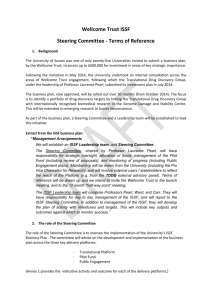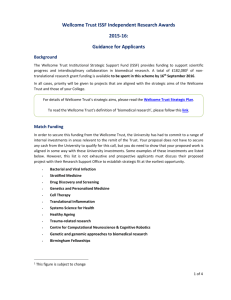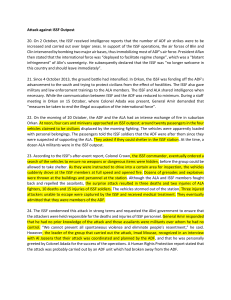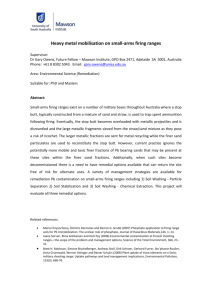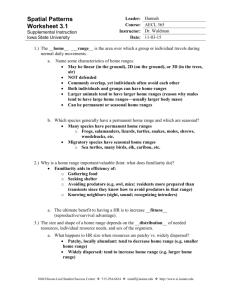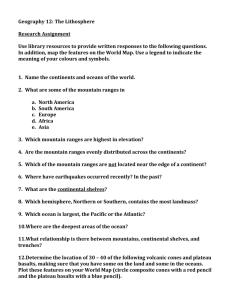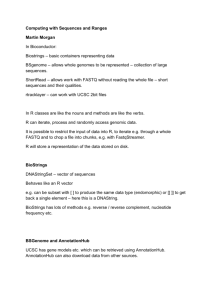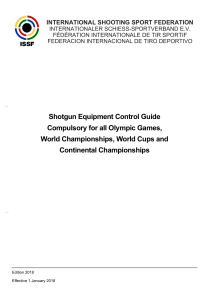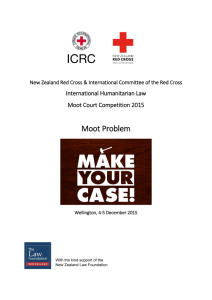Some explanations to the ISSF General
advertisement
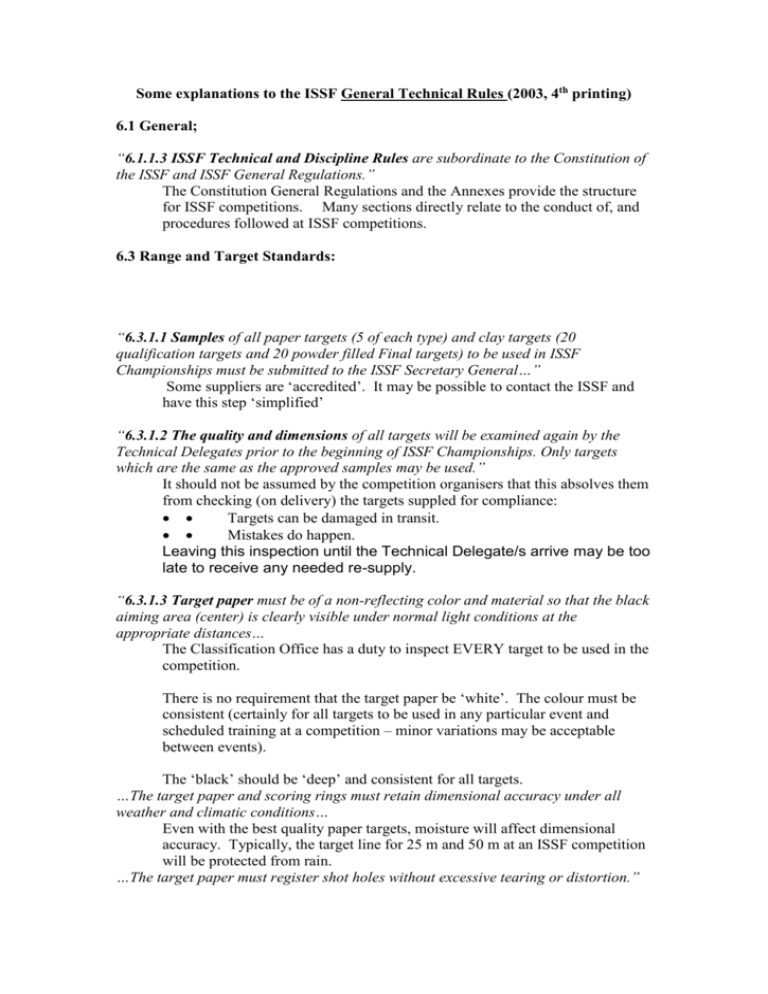
Some explanations to the ISSF General Technical Rules (2003, 4th printing) 6.1 General; “6.1.1.3 ISSF Technical and Discipline Rules are subordinate to the Constitution of the ISSF and ISSF General Regulations.” The Constitution General Regulations and the Annexes provide the structure for ISSF competitions. Many sections directly relate to the conduct of, and procedures followed at ISSF competitions. 6.3 Range and Target Standards: 45 87 54 “6.3.1.1 Samples of all paper targets (5 of each type) and clay targets (20 qualification targets and 20 powder filled Final targets) to be used in ISSF Championships must be submitted to the ISSF Secretary General…” Some suppliers are ‘accredited’. It may be possible to contact the ISSF and have this step ‘simplified’ “6.3.1.2 The quality and dimensions of all targets will be examined again by the Technical Delegates prior to the beginning of ISSF Championships. Only targets which are the same as the approved samples may be used.” It should not be assumed by the competition organisers that this absolves them from checking (on delivery) the targets suppled for compliance: Targets can be damaged in transit. Mistakes do happen. Leaving this inspection until the Technical Delegate/s arrive may be too late to receive any needed re-supply. “6.3.1.3 Target paper must be of a non-reflecting color and material so that the black aiming area (center) is clearly visible under normal light conditions at the appropriate distances… The Classification Office has a duty to inspect EVERY target to be used in the competition. There is no requirement that the target paper be ‘white’. The colour must be consistent (certainly for all targets to be used in any particular event and scheduled training at a competition – minor variations may be acceptable between events). The ‘black’ should be ‘deep’ and consistent for all targets. …The target paper and scoring rings must retain dimensional accuracy under all weather and climatic conditions… Even with the best quality paper targets, moisture will affect dimensional accuracy. Typically, the target line for 25 m and 50 m at an ISSF competition will be protected from rain. …The target paper must register shot holes without excessive tearing or distortion.” With ISSF approved targets, this is usually only a problem when shooters use low velocities in 10 m events. “6.3.2.4. (25 Meter Rapid Fire Pistol Target) …White horizontal aiming lines replace the ring values at the left and the right side of the target center…” ‘…white…’ here means the same colour as the target paper. There is no need for a separate ‘pure white’ overprint. “6.3.2.8 Clay Targets (for shotgun events): The color of the clay target must be specified in all programs for ISSF Championships. The color of a target which is selected for a ISSF Championship must be clearly visible against the background of the range under all normal lighting conditions…” This will vary from range to range. The colour to be used is selected in consultation with the Technical Delegates. “6.3.3 (Paper Sighting Targets) Sighting targets must be marked clearly with a black diagonal stripe in the upper right hand corner of the target…. There is a difference between a ‘diagonal’ and a ‘skew’ line. diagonal skew While either is acceptable, for pistol on paper targets and EST use the ‘skew’. …The stripe must be clearly visible to the naked eye at the appropriate distance under normal light conditions (Except for Rapid Fire Pistol Target).” For 25 m and 50m, a line at least 10 mm wide is recommended. 6.3.5 Range Standards; 45 87 54 “6.3.5.1.1 The ISSF Technical Delegates, in accordance with ISSF General Regulations Articles 3.4.2, 3.4.3 and 3.4.4, and in cooperation with the Match Director and range officials appointed by the Organizing Committee for the different disciplines, must inspect the shooting ranges and equipment for all ISSF Championships… 3.4.3 once, 10 to 12 months before the Championship, and again, not less than 10 days before the opening ceremony. …They… The Technical Delegates. …may approve small deviations from specifications in ISSF Rules which do not conflict with the intent and spirit of ISSF Regulations and Rules, except that no deviations in shooting distances and target specifications are allowed… For 10, 25, 50 and 300 m ranges, modern surveying and construction methods should ensure that all range dimensions are well within the tolerances allowed by the ISSF rules. …Participating countries or federations must be notified of all approved deviations prior to the closing date for entries in the competition.” “6.3.5.1.2 New outdoor ranges should be constructed in such a way that the sun is behind the shooter as much as possible during the competition day.” While this has obvious particular application to shotgun ranges, it also applies to25, 50 and 300 m ranges. Also to be considered for 25, 50 and 300 m ranges are: the shadows cast on targets by range dividing walls, overhead safety baffles, building support structures, etc. direct sunlight from behind the shooters should not be allowed to interfere. “6.3.6.3.4 10 m air gun ranges for ISSF competitions and Olympic Games must be installed indoors in accordance with ISSF General Regulation Article 3.5.1.” In contrast with shotgun, 10, 25 & 50 m ranges (for which ‘outdoor’ conditions are expected), 10 m ranges operate in a ‘controlled’ environment for which: Light conditions remain constant Cross-winds are not a factor “6.3.6.5.1 Space must be provided for spectators. This area must be separated from the area for shooters and officials by a suitable barrier located at least 5 m behind the firing line.” This minimum is barely sufficient for ranges using paper targets. For EST where printer tables additional distance is required. Where the media is to also be accommodated in the competition area, further additional distance is required. “6.3.6.7 Each range must be equipped with a large clock at each end of the hall that can be seen clearly by shooters and officials.” Competition administrators and range officials should be aware that there may be three slightly differing ‘times’ in operation at a major competition. E.g. at Olympics: Computer ‘time’ for the ESTs Broadcast ‘time’ for the media Range time, as shown by the range clocks “6.3.6.8 Target frames or mechanisms must be marked with numbers corresponding to their firing point number… This numbering may vary due to differing range configuration through the competition programme; e.g.: For dedicated Finals ranges dealing with differing events, For ranges used for both Qualification and Finals rounds For 25 m ranges 6.3.7 Wind Flags: 6.3.7.1 (Wind flags) Rectangular wind flags, which indicate air movements on the range, should be made of a cotton material weighing approximately 150 g/m²… A common problem is with suppliers who ‘hem’ and/or ‘overlock’ the edges of the fabric. This can significantly affect the stiffness of the fabric. …They must be placed as close to the bullets flight path as possible without interfering with the bullets or the shooter's view of the target during aiming… This may require a compromise height to suit 3-position rifle events. …The color of the wind flags must be in contrast to the background. Dual color or striped wind flags are permitted and recommended.” Should be plainly visible against the background. “6.3.7.3.1 If a 50 m range is also used as a 10 m enclosed range the 10 m wind flags must be placed far enough outside of the walls so that they give indication of the wind.” This condition is encountered with dedicated Finals ranges. 6.3.12 General Firing Point standards: “6.3.12.2.1 (General firing point standards 300 m, 50 m, 10 m) A removable or adjustable bench or stand, 0.7 m - 0.8 m high.” For 10 m ranges a fixed bench is commonly encountered. “6.3.12.2.3 A chair or stool for the shooter.” Accepted practice for ISSF competitions is to allow the coach to sit IMMEDIATELY forward of the spectator barrier; seating should be provided. “6.3.15.1 (10 m ranges) The firing point must be a minimum of 1 m wide.” To avoid ‘disputes’ between shooters, it recommended that these bays be marked. 6.3.15.4 Indoor 10 m ranges: “6.3.15.4 Indoor 10 m ranges must have artificial illumination providing the necessary amount of light without glare or distracting shadows on the targets or firing points. The entire area must be evenly illuminated with no less than 300 lux… Important here is “…entire…”, and “…evenly…”. Architects may argue that 6.3.15.4.2 only requires that the minimum 300 lux applies to the firing bench and a point midway down range. To meet the “…evenly…” requirement the entire area from at least the rear of the firing bays to the targets must meet the 200-lux minimum. “…evenly…” is just as important. The firing points and down-range area should not have any noticeably bright, or dull areas. …Targets must be illuminated evenly with no less than 1000 lux… The illumination method shown in Figure 10 is descriptive, not prescriptive! The use of individual lamps for each target face is not without problems when it comes to adjustment to obtain even lighting across the face of the target. Additionally, all the target faces in a 10 m range should appear to have equivalent lighting. …The background area behind the targets must be a non-reflecting, light even neutral color… Not dark, not uneven; “…light even neutral…” …If due to the request from the media, the lighting on the firing points has to be increased, then the light on the targets must be appropriately increased.” Where a separate Finals range is installed for the Olympics, the TV media will expect at least 5000 lux on the shooters. “6.3.15.4.1 (10 m) Measuring of the target illumination (minimum 1000 lux) must be done with the measuring device held at the level of the target and pointed toward the firing point (A).” And at the face of the target. 6.3.16 25 m ranges: “6.3.16.5 (25 m) Firing points must be separated by transparent screens…” The screens are to provide protection against ejected cartridge cases from adjacent bays. They must allow the Range Officer to view the shooters’ position and actions. “6.3.16.6.1 (25 m) A removable or adjustable bench or table, approximately 0.5 m x 0.6 m in size and 0.7 m to 0.8 m high.” Some EST installations as supplied by the manufacturer do not meet this requirement, having a continuous bench corresponding to each group of targets. The continuous bench may pose difficulties for shorter shooters when coming to the READY position. 6.3.18 Running Target ranges: “6.3.18.4 (Running Target) Ranges must be constructed to prevent any person from being exposed to danger during shooting.” The sound levels experienced in the target pit for paper targets (including 10 m installations) may require hearing protection for the personnel. 6.3.22 Shotgun ranges: “6.3.22.5 (Shotgun) A safety shield must be installed at the opening of each traphouse…” This safety shield should not have any exposed metal facing the shooting stations to prevent ricochets when steel shot is used. 6.5.7. Practice Shooting: “6.5.7.2 A specially designated function firing range, without targets, must be provided for shooters to test guns during days of competition.” This range is for the testing of firearms FUNCTION, not for sighting-in. No targets are provided on this range. 6.9 Media: “6.9.1 Suitable facilities, assistance and cooperation must be provided for the press, radio, and television personnel, to ensure publicity. During competitions, however, the competitors must not be disturbed by photography and/or interviews.” It is usual to provide ‘marshals’ to escort media personnel whenever they are in the competition areas. These marshals should have the necessary experience in both the safety requirements and competition procedures.
